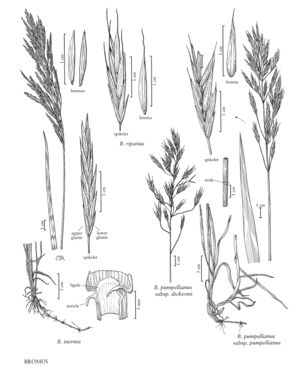Difference between revisions of "Bromus inermis"
FNA>Volume Importer |
imported>Volume Importer |
||
| Line 4: | Line 4: | ||
|publications= | |publications= | ||
|common_names=Smooth brome;Hungarian brome;Brome inerme | |common_names=Smooth brome;Hungarian brome;Brome inerme | ||
| + | |special_status={{Treatment/ID/Special_status | ||
| + | |code=I | ||
| + | |label=Introduced | ||
| + | }} | ||
|basionyms= | |basionyms= | ||
|synonyms={{Treatment/ID/Synonym | |synonyms={{Treatment/ID/Synonym | ||
| Line 28: | Line 32: | ||
-->{{Treatment/Body | -->{{Treatment/Body | ||
| − | |distribution=Pa.;Conn.;N.J.;N.Y.;Wash.;Va.;Del.;D.C;Wis.;W.Va.;Kans.;Minn.;N.Dak.;Nebr.;Okla.;S.Dak.;Mass.;Maine;N.H.;R.I.;Vt.;Wyo.;N.Mex.;Tex.;La.;Ariz.;Idaho;Mich.;N.C.;Tenn.;Calif.;Nev.;Ark.;Colo.;Ga.;Iowa;Ill.;Ind.;Ky.;Md.;Mo.;Miss.;Mont.;Ohio;Oreg.;Utah;Alaska;Alta.;B.C.;Greenland;Man.;N.B.;Nfld. | + | |distribution=Pa.;Conn.;N.J.;N.Y.;Wash.;Va.;Del.;D.C.;Wis.;W.Va.;Kans.;Minn.;N.Dak.;Nebr.;Okla.;S.Dak.;Mass.;Maine;N.H.;R.I.;Vt.;Wyo.;N.Mex.;Tex.;La.;Ariz.;Idaho;Mich.;N.C.;Tenn.;Calif.;Nev.;Ark.;Colo.;Ga.;Iowa;Ill.;Ind.;Ky.;Md.;Mo.;Miss.;Mont.;Ohio;Oreg.;Utah;Alaska;Alta.;B.C.;Greenland;Man.;N.B.;Nfld. and Labr.;N.S.;N.W.T.;Nunavut;Ont.;P.E.I.;Que.;Sask.;Yukon;S.C. |
|discussion=<p><i>Bromus inermis</i> is native to Eurasia, and is now found in disturbed sites in Alaska, Greenland, and most of Canada as well as south throughout most of the contiguous United States except the southeast. It has also been used for rehabilitation, and is planted extensively for forage in pastures and rangelands from Alaska and the Yukon Territory toTexas.</p><!-- | |discussion=<p><i>Bromus inermis</i> is native to Eurasia, and is now found in disturbed sites in Alaska, Greenland, and most of Canada as well as south throughout most of the contiguous United States except the southeast. It has also been used for rehabilitation, and is planted extensively for forage in pastures and rangelands from Alaska and the Yukon Territory toTexas.</p><!-- | ||
--><p><i>Bromus inermis</i> is similar to <i>B. pumpellianus</i>, differing mainly in having glabrous lemmas, nodes, and leaf blades, but lack of pubescence is not a consistently reliable distinguishing character. <i>Bromus inermis</i> also resembles a recently introduced species, <i>B. riparius</i>, from which it differs primarily in its shorter or nonexistent awns.</p> | --><p><i>Bromus inermis</i> is similar to <i>B. pumpellianus</i>, differing mainly in having glabrous lemmas, nodes, and leaf blades, but lack of pubescence is not a consistently reliable distinguishing character. <i>Bromus inermis</i> also resembles a recently introduced species, <i>B. riparius</i>, from which it differs primarily in its shorter or nonexistent awns.</p> | ||
| Line 47: | Line 51: | ||
|illustrator=Cindy Roché | |illustrator=Cindy Roché | ||
|illustration copyright=Utah State University | |illustration copyright=Utah State University | ||
| − | |distribution=Pa.;Conn.;N.J.;N.Y.;Wash.;Va.;Del.;D.C;Wis.;W.Va.;Kans.;Minn.;N.Dak.;Nebr.;Okla.;S.Dak.;Mass.;Maine;N.H.;R.I.;Vt.;Wyo.;N.Mex.;Tex.;La.;Ariz.;Idaho;Mich.;N.C.;Tenn.;Calif.;Nev.;Ark.;Colo.;Ga.;Iowa;Ill.;Ind.;Ky.;Md.;Mo.;Miss.;Mont.;Ohio;Oreg.;Utah;Alaska;Alta.;B.C.;Greenland;Man.;N.B.;Nfld. | + | |distribution=Pa.;Conn.;N.J.;N.Y.;Wash.;Va.;Del.;D.C.;Wis.;W.Va.;Kans.;Minn.;N.Dak.;Nebr.;Okla.;S.Dak.;Mass.;Maine;N.H.;R.I.;Vt.;Wyo.;N.Mex.;Tex.;La.;Ariz.;Idaho;Mich.;N.C.;Tenn.;Calif.;Nev.;Ark.;Colo.;Ga.;Iowa;Ill.;Ind.;Ky.;Md.;Mo.;Miss.;Mont.;Ohio;Oreg.;Utah;Alaska;Alta.;B.C.;Greenland;Man.;N.B.;Nfld. and Labr.;N.S.;N.W.T.;Nunavut;Ont.;P.E.I.;Que.;Sask.;Yukon;S.C. |
|reference=None | |reference=None | ||
|publication title= | |publication title= | ||
|publication year= | |publication year= | ||
| − | |special status= | + | |special status=Introduced |
| − | |source xml=https:// | + | |source xml=https://bibilujan@bitbucket.org/aafc-mbb/fna-data-curation.git/src/bb6b7e3a7de7d3b7888a1ad48c7fd8f5c722d8d6/coarse_grained_fna_xml/V24/V24_285.xml |
|subfamily=Poaceae subfam. Pooideae | |subfamily=Poaceae subfam. Pooideae | ||
|tribe=Poaceae tribe Bromeae | |tribe=Poaceae tribe Bromeae | ||
Revision as of 21:46, 27 May 2020
Plants perennial; rhizomatous, rhizomes short to long-creeping. Culms 50-130 cm, erect, single or a few together; nodes (2)3-5(6), usually glabrous, rarely pubescent; internodes usually glabrous, rarely pubescent. Sheaths usually glab¬rous, rarely pubescent or pilose; auricles sometimes present; ligules to 3 mm, glabrous, truncate, erose; blades 11-35(42) cm long, 5-15 mm wide, flat, usually glabrous, rarely pubescent or pilose. Panicles 10-20 cm, open, erect; branches ascending or spreading. Spikelets 20-40 mm, elliptic to lanceolate, terete to moderately laterally compressed, sometimes purplish, with (5)8-10 florets. Glumes glabrous; lower glumes (4)6-8(9) mm, 1(3)-veined; upper glumes (5)7-10 mm, 3-veined; lemmas 9-13 mm, elliptic to lanceolate, rounded over the midvein, usually glabrous and smooth, sometimes scabrous, margins sometimes sparsely puberulent, the basal part of the backs less frequently so, apices acute to obtuse, entire; awns absent or to 3 mm, straight, arising less than 1.5 mm below the lemma apices; anthers 3.5-6 mm. 2n = 28, 56.
Distribution
Pa., Conn., N.J., N.Y., Wash., Va., Del., D.C., Wis., W.Va., Kans., Minn., N.Dak., Nebr., Okla., S.Dak., Mass., Maine, N.H., R.I., Vt., Wyo., N.Mex., Tex., La., Ariz., Idaho, Mich., N.C., Tenn., Calif., Nev., Ark., Colo., Ga., Iowa, Ill., Ind., Ky., Md., Mo., Miss., Mont., Ohio, Oreg., Utah, Alaska, Alta., B.C., Greenland, Man., N.B., Nfld. and Labr., N.S., N.W.T., Nunavut, Ont., P.E.I., Que., Sask., Yukon, S.C.
Discussion
Bromus inermis is native to Eurasia, and is now found in disturbed sites in Alaska, Greenland, and most of Canada as well as south throughout most of the contiguous United States except the southeast. It has also been used for rehabilitation, and is planted extensively for forage in pastures and rangelands from Alaska and the Yukon Territory toTexas.
Bromus inermis is similar to B. pumpellianus, differing mainly in having glabrous lemmas, nodes, and leaf blades, but lack of pubescence is not a consistently reliable distinguishing character. Bromus inermis also resembles a recently introduced species, B. riparius, from which it differs primarily in its shorter or nonexistent awns.
Selected References
None.
